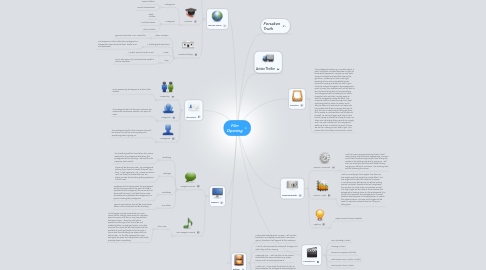
1. Characters
1.1. Passers-by
1.1.1. Some passers by will appear to make it look realistic.
1.2. Antagonist
1.2.1. The antagonist will not be seen, however the camera will sometimes switch to his point of view .
1.3. Protagonist
1.3.1. The protagonist will be the character who will be chased. He will be running away and wondering what is going on.
2. Diagesis
2.1. Diagetic Sounds
2.1.1. Breathing
2.1.1.1. The breathing will be heard when the view is switched to the antagonist and when the protagonist will be running. I will add this for suspense and realistic.
2.1.2. Dialogue
2.1.2.1. There will be few lines said. The protagonist will say those lines to himself, they will vary from "What's going on" to "Leave me alone". I will use these to create effect on the audience who should start getting questions in their head.
2.1.3. Footsteps
2.1.3.1. Footsteps will be heard when the protagonist will be running or when the point of view is switched to the antagonist; the sound of suit shoes will be heard. I will add this to make the audience understand the antagonist is a person chasing the protagonist.
2.1.4. Gun Shots
2.1.4.1. Typical conventions, this will be heard when either of the characters will be shooting.
2.2. Non-Diagetic Sounds
2.2.1. The Music
2.2.1.1. At the beginning there would be no music. There will be a single note when the character opens his eyes, and then a very low-pitched and quiet music. When the red light is spotted and the gun shot, the music will suddenly fasten up and get louder. From that moment the music will be fast-paced until the end where it will get louder to build up to a climax and then suddenly die down with the dark screen. As the title appears the music will again be quiet and low-pitched until finally quieting down completely.
3. Editing
3.1. Fast-paced editing when running; I will use this because it is a typical convention in an action genre; therefore it will appeal to the audience.
3.2. A lot of cuts because the scene will change a lot when they will be running
3.3. Continuity Cut - I will use this cut for scenes that follow the same narrative e.g. action scenes such as chasing someone.
3.4. Match Cut - I have used these kind of cuts to jump between the antagonist and protagonist views; therefore the narrative makes sense but is in different shots.
3.5. Cross Cutting - It could be said that I will use this kind of cut at the beginning where it jumps from the protagonist to the antagonist's point of view; this is because they are both in different places and are focused on different actions; It will build suspense.
4. Mise En Scene
4.1. Props
4.1.1. Fake guns
4.1.1.1. Typical convention in an action
4.1.2. Red Laser
4.1.2.1. This will work as the light coming out of the antagonist's gun
4.1.3. Memory Stick
4.1.3.1. Creates mystery and makes the audience ask questions
4.2. Costume
4.2.1. Protagonist
4.2.1.1. Casual Clothes
4.2.1.2. Casual Shoes/Boots
4.2.2. Antagonist
4.2.2.1. Black Clothes
4.2.2.2. Suit black shoes
4.2.2.3. Clean Clothes
4.3. Location/Setting
4.3.1. Urban Location
4.3.1.1. Typical convention in an Action film
4.3.2. A building/with dead end
4.3.2.1. This happens a lot to either the protagonist or antagonist, where they lost their 'battle' and are captivated.
4.3.3. A park
4.3.3.1. A public place to make it real
4.3.4. Alley
4.3.4.1. This is also seen a lot, and would be useful in various situations.
5. Cinematography
5.1. Camera Movement
5.1.1. I will use pans, perhaps tracking shots if it will work, zooms and tilts where appropriate. The pan and tilt will be advancing the plot and telling the audience the setting and what is going on. I will also use a fast pan shot that will make it blurry and give an effect of confusion. The tracking shot will be following the action.
5.2. Camera Angle
5.2.1. I will use mostly eye level angles, but also use low angles and high angles to create effect. The low angle will be used to make the character in-narrative more effective as he will be looking around confused, therefore this will emphasize the emotion as it will make us confused as well. The high angle will be used at the end when the antagonist is looking down on the protagonist; this informs the audience the protagonist is in a bad situation and because it is looking down, it makes the subject inferior. The eye level angles will be used to make the audience feel as if they are taking part.
5.3. Lighting
5.3.1. Deep Focus to keep it realistic
